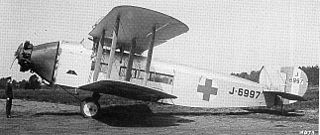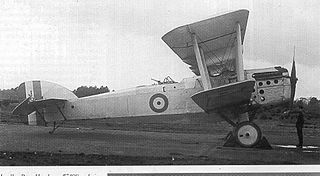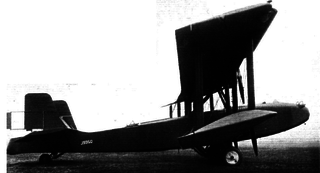Related Research Articles
The Aircraft Manufacturing Company Limited (Airco) was an early British aircraft manufacturer. Established during 1912, it grew rapidly during the First World War, referring to itself as the largest aircraft company in the world by 1918.
Westland Aircraft was a British aircraft manufacturer located in Yeovil, Somerset. Formed as a separate company by separation from Petters Limited just before the start of the Second World War, Westland had been building aircraft since 1915. During the war the company produced a number of generally unsuccessful designs, but their Lysander would serve as an important liaison aircraft with the Royal Air Force. After the war the company focused on helicopters, and was merged with several other British firms to create Westland Helicopters in 1961.

The Bristol Jupiter was a British nine-cylinder single-row piston radial engine built by the Bristol Aeroplane Company. Originally designed late in World War I and known as the Cosmos Jupiter, a lengthy series of upgrades and developments turned it into one of the finest engines of its era.

The Handley Page HP.81 Hermes was a British civilian airliner built by Handley Page in the 1940s and 1950s. Closely related to Handley Page's Hastings military transport, the Hermes was a low-wing monoplane powered by four piston engines. Twenty-nine were built, serving briefly with BOAC in the early 1950s and later with several charter airlines.

The Handley Page H.P.42 and H.P.45 were four-engine biplane airliners designed and manufactured by British aviation company Handley Page, based in Radlett, Hertfordshire. It held the distinction of being the largest airliner in regular use in the world upon the type's introduction in 1931.

The Handley Page Hinaidi was one of two twin-engine bombers built by Handley Page that served with the Royal Air Force between 1925 and 1935. The aircraft was developed from the Handley Page Hyderabad and named after Hinaidi, an RAF station in Iraq.

The de Havilland DH.61 Giant Moth was a 1920s British large single-engined biplane transport built by de Havilland at Stag Lane Aerodrome, Edgware. Intended primarily for use in Australia, a number were also shipped to Canada.

The de Havilland DH.50 was a 1920s British large single-engined biplane transport built by de Havilland at Stag Lane Aerodrome, Edgware, and licence-built in Australia, Belgium, and Czechoslovakia.

The Bristol Ten-seater and Bristol Brandon were British single-engine biplane transport aircraft built by the Bristol Aeroplane Company in the early 1920s. Only three were built, two of which were used as civil transports and one of which served with the Royal Air Force.

The Bristol Boarhound was a British army cooperation and liaison aircraft of the 1920s. It was a two-seat biplane with wings of equal span, of steel frame construction with fabric covering.
The Bristol Type 91 Brownie was a light sports aircraft produced in the United Kingdom by the Bristol Aeroplane Company in 1924. It was a low-wing cantilever monoplane aircraft of conventional configuration with fixed tailskid undercarriage. The pilot and passenger sat in tandem open cockpits. It won the £1,000 pound prize for second place at the Lympne light aircraft trials in October 1924.
The Westland Yeovil was a British biplane bomber designed and built by Westland Aircraft in 1923 to meet an Air Ministry Specification for a single-engined day bomber.

The Westland Interceptor was a fighter developed by the British company Westland Aircraft to Air Ministry Specification F.20/27. When tested in 1929 and 1930, it showed unsatisfactory handling characteristics and was rejected by the RAF in favour of the Hawker Fury biplane fighter.

The Bristol Seely was entered into an Air Ministry competition for safe civil aeroplanes held in 1920. It was a single-engine biplane with accommodation for one passenger. After the competition, the single Seely was used as a testbed for the Bristol Jupiter engine development programme.

The Bristol Berkeley was built to a British government specification for a single-engine day or night bomber. Three of these two-seat biplanes were built, but no contract for further production was awarded.
The Airscrew Company Ltd was a British manufacturing company based in Surrey manufacturing propellers.
Hordern-Richmond was a British aeronautical engineering company that traded between 1937 and c. 1990.

The Handley Page Handcross was a single-engined biplane day bomber built to an Air Ministry specification. It was not put into production and only the three prototypes were built.

The sole Boulton & Paul P.32 was a British three-engined biplane built to an Air Ministry specification for a long range night bomber. A lack of engine availability slowed construction and by the time it went for tests the thinking on bomber types had moved on.
The Westland PV.7 was a private venture submission to a 1930s British specification for a general-purpose military aircraft with two crew. It was a single-engined, high-wing monoplane of promise, but was destroyed early in official tests.
References
- 1 2 3 4 5 Ord-Hume, Arthur W.J.G. (2000). British Light Aeroplanes. Peterborough: GMS Enterprises. p. 600. ISBN 978-1-870384-76-6.
- ↑ "Rubery, Owen & Co". Flight . Vol. XVI no. 22. 29 May 1924. p. 345.
- 1 2 "All-metal airscrews". Flight . Vol. XII no. 53. 25 January 1920. pp. 1307–9.
- 1 2 Barnes, C.H. (1970). Bristol Aircraft since 1910. London: Putnam Publishing. p. 145. ISBN 0-370-00015-3.
- ↑ "No. 33135". The London Gazette . 23 February 1926. p. 1362.
- ↑ "No. 33229". The London Gazette . 14 December 1926. p. 8219.
- ↑ Barnes (1970) p.187
- ↑ Barnes (1970) p.155
- ↑ Barnes, C.H.; James, D. N. (1987). Handley Page Aircraft since 1907. London: Putnam Publishing. p. 251. ISBN 978-0-851-77803-7.
- ↑ "The Paris Aero Show 1922". Flight . Vol. XV no. 4. 25 January 1923. pp. 45–7.
- ↑ James, Derek (1991). Westland Aircraft since 1915. London: Putnam Publishing. p. 124. ISBN 0-85177-847-X.